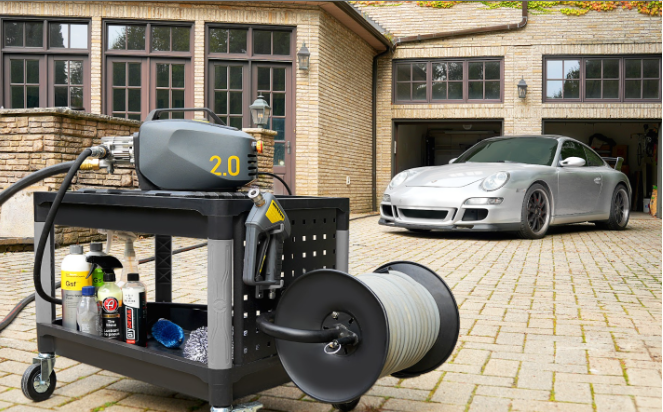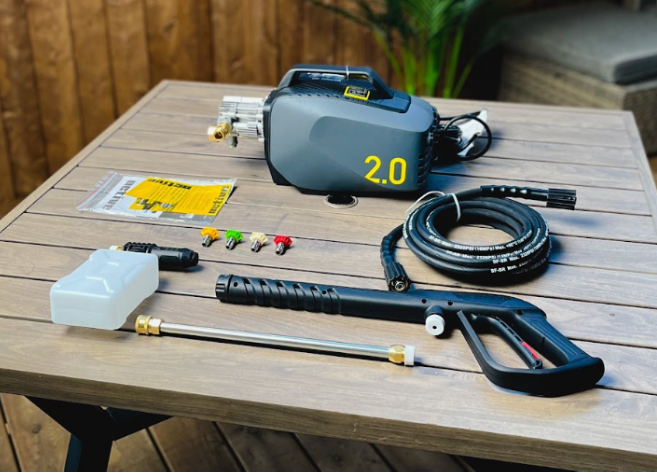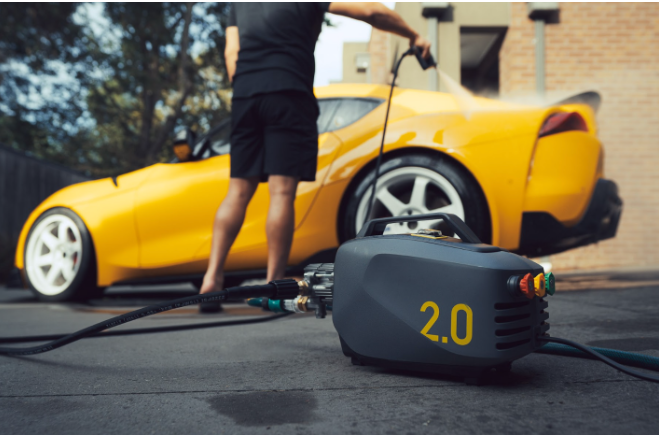From maintaining the sleek shine of your car to preparing it for a fresh coat of paint, there’s little that the right pressure washer can’t do for an automotive enthusiast.
In this comprehensive guide, you will not only learn how to select the ideal pressure washer for your automotive needs as a typical home user or a professional, but also discover the key differences between types and understand how to maintain your pressure washers in the long term.
The Essentials of Automotive Pressure Washing
Pressure washing your vehicle goes beyond basic cleanliness; it’s about preserving your car’s value and appearance.
Regular cleaning with the right pressure washer can prevent the build-up of harmful substances like salt, grime, and pollutants, which can cause corrosion and damage over time.
Electric vs. Gas Pressure Washers for Car Cleaning
Understanding the type of pressure washer that best suits your needs is crucial. The 2 main categories of pressure washers are electric pressure washers and gas pressure washers.
Each type comes with its own set of advantages and limitations, tailored to different cleaning environments and tasks.
Electric Pressure Washers
- Advantages: Electric pressure washers are ideal for most car owners due to their quieter operation, environmental friendliness, and ease of maintenance. They are generally more compact and lighter, making them easy to manoeuvre and store.
- Suitable For: Regular car maintenance, especially in residential areas where noise might be a concern.
- Popular Models: Examples include the Ozito HPW 2030, Gerni GPW-3300 and Karcher K2 Plus, known for their efficiency and user-friendly features.
Gas Pressure Washers
- Advantages: Gas models offer higher PSI and LPM, making them suitable for removing tough stains and for use in commercial settings. They provide mobility and power where access to electricity is limited.
- Suitable For: Heavy-duty cleaning tasks and commercial use where greater power is needed.
- Considerations: They are heavier, noisier, and require more maintenance compared to electric models.
Choosing The Right Pressure Washer Based on Use-Case Scenarios

Selecting the right pressure washer is easier when you know what you will be using it for:
For the Typical Home User (Weekly Wash)
- Budget: A$350-600
- Recommendations: Ideal models include units like the Active 2.0 Pressure Washer Full Kit M22-14, which offers at least 7 LPM flow rate, universal connections for easy upgrades, and a long, non-kink hose that is practical for navigating around the vehicle.
- Features: Look for compactness for easy storage, universal connections for versatility in attachments, and sufficient flow rate for effective cleaning.
For the Professional (Frequent Use, Long- Term)
- Budget: Above A$850
- Recommendations: The Kranzle KHD7-122TS Professional Pressure Washer is highly recommended for its durability, lower operating speeds, and noise levels.
- Features: Robust pumps and motors, durable hoses, and full stainless steel connections are crucial for long-term use and frequent, diverse cleaning tasks.
Identifying Your Pressure Washer Needs
When it comes to pressure washers, one size does not fit all. Identifying your specific car cleaning needs will guide you through the multitude of options available.
Here we explore factors that will lead to the ideal pressure washer for you.
PSI and LPM Requirements
The Pressure Per Square Inch (PSI) is the force of water output, while Litres Per Minute (LPM) is the amount of water used.
For car washing, a pressure washer with a PSI of around 1200 to 1900 and a LPM of 6 to 8 should be adequate.
The Type of Dirt and Grime
Consider the types of dirt you usually encounter. For general car washes, an entry-level model will suffice.
However, if you frequently deal with tough mud, a more powerful washer might be necessary.
The Right Pressure Washer for Auto Detailing

Precision is key when it comes to pressure washing for auto detailing. You don’t want to cause damage inadvertently. We lay out the key features that are essential for maximising efficiency and protection during your car cleaning sessions.
Helpful Inclusions
When choosing a pressure washer for vehicle detailing, practicality is key. Here are three crucial inclusions to look for:
- Long Hose: Opt for a minimum hose length of 15 metres to facilitate easy movement around the vehicle, ensuring every part is accessible without repositioning the washer.
- Swivel Gun: A short gun equipped with a swivel feature is indispensable for its manoeuvrability, allowing you to easily reach tight spaces and intricate angles.
- Extension Wand: An extension wand is vital for cleaning hard-to-reach areas like the vehicle’s roof and undercarriage, enhancing the thoroughness of the detailing process.
Water Flow and Its Role
Litres Per Minute (LPM) is just as important as PSI. The higher the LPM, the more water is used, leading to a quicker and more efficient clean. However, a balance needs to be struck to avoid unnecessary wastage.
Nozzles for Specific Tasks
Different nozzles provide varied spray patterns from a pinpoint spray to a wide fan for different cleaning tasks. For cars, the 25-degree nozzle is the bare minimum, with 40-degrees being our recommendation, providing a good balance of force and spread.
Maintenance Tips for Pressure Washers
Proper maintenance of your pressure washer can extend its life and ensure safe and effective operation.
Here are the top four maintenance tips to keep your pressure washer in optimal condition:
- Priming and Flushing: Before turning on the machine, it’s important to prime it. This involves running water through the system to ensure that all internal components are wet and ready to operate, which helps prevent damage from dry starting.
Equally important is the process of flushing out the machine after use. Make sure to clear any entrapped air from the system by running clean water through it for a few minutes. This step removes any residue and air pockets that could lead to corrosion or damage during storage. - Clean and Replace Nozzles as Needed: Over time, nozzles can become clogged with dirt and debris, which can restrict water flow and affect the performance of your pressure washer. Regularly clean the nozzles with a pin or small needle to remove any blockages. If a nozzle is worn out or damaged, replace it to ensure optimal performance and to prevent damage to the surfaces you’re cleaning.
- Seasonal Storage Preparation: Even in milder climates like Australia’s, preparing your pressure washer for periods of non-use is important. After the final use of the season, thoroughly clean and dry the machine. Ensure all water is expelled from the system to prevent any stagnation or mildew during storage. Cover the unit and store it in a dry, protected area to avoid dust and debris accumulation.
- Regular Engine Maintenance (for Gas Models): For gas-powered pressure washers, regular engine maintenance is essential. This includes changing the oil, checking the spark plug, and cleaning or replacing the air filter. These steps will ensure the engine runs smoothly and reduces the likelihood of operational problems.
Always refer to the manufacturer’s guidelines for specific maintenance schedules and procedures.
By following these maintenance tips, you can help ensure that your pressure washer remains a reliable tool for your cleaning tasks, providing optimal performance year after year.
Conclusion
Choosing the right pressure washer for your car involves more than just picking between electric and gas models—it’s about understanding your specific cleaning needs and how different washers can meet them.
Whether you’re a home user looking for a compact and easy-to-manoeuvre unit for weekly car washes, or a professional needing a robust machine for diverse cleaning tasks, there’s a pressure washer out there to suit your requirements.
Frequently Asked Questions (FAQs)
For car cleaning, a pressure washer with a PSI range of 1200 to 1900 is ideal. This range is strong enough to effectively clean your vehicle without risking damage to the paint or finish.
Electric pressure washers are generally better for car washing due to their quieter operation, lower PSI (which reduces the risk of damaging the car’s surface), and ease of use. However, if you require more power for other tasks in addition to car washing, a gas pressure washer might be more suitable.
No, not all detergents are suitable for use with a foam cannon. Here’s why and what you should use instead:
- Effectiveness: Regular detergents may not be concentrated enough to produce the thick foam needed for effective pre-washing.
- Safety for Paint: Many are not pH neutral. Using harsh detergents can remove waxes and sealants, potentially damaging your car’s paint.
- Compatibility: Some detergents might harm the foam cannon’s mechanism.
Recommended Options:
- Foam Cannon Detergent: These are specifically formulated to generate thick foam and are safe for car paint.
- Car Wash Soap: Ensure it is suitable for use in foam cannons and follow the manufacturer’s dilution guidelines.
Tip: Always opt for products labelled as “pH neutral” and “snow foam compatible” to ensure compatibility and safety for your car’s finish.
You can use a pressure washer on your car as often as needed. For most car owners, washing the car every two weeks is sufficient. However, if your car is exposed to more dirt, salt, or pollutants, you may need to wash it more frequently.
A 25-degree (green) nozzle is typically the best choice for washing cars. It provides a strong enough spray to be effective but is gentle enough to avoid damage to your car’s exterior.
High-pressure water can potentially remove wax or sealant, especially if it’s applied directly at close range. To avoid this, use a lower pressure setting, choose the right nozzle, and maintain a safe distance from the car’s surface.
PSI (Pounds per Square Inch) measures the pressure of water, indicating how forcefully the water strikes the surface. LPM (Litres Per Minute) measures the flow rate, indicating how much water is used. Both are important for efficient cleaning—PSI for the cleaning force and LPM for the speed and breadth of cleaning.
For electric models, ensure it’s stored in a dry, safe place and check cords and connections for damage before use. For gas models, check oil levels, ensure proper fuel storage, and run the engine periodically if it’s not in regular use. Regularly inspect nozzles and hoses for blockages or wear and tear.
If you’re only using the pressure washer for your car and occasional small tasks around the house, an enthusiast-level model should suffice. Prosumer models are ideal for those who need a more powerful machine for frequent or more demanding tasks beyond just car washing.
Yes, but it requires caution. Avoid direct high-pressure spray on sensitive components and electrical parts. It’s safer to use lower pressure and ensure that water doesn’t penetrate electrical connections or air intakes. If unsure, consult your vehicle’s manual or a professional.
-

Calvin has extensive experience in the multifaceted engineering space, enabling him to overcome new challenges daily. His unique blend of technical expertise and business acumen allows him to tackle complex problems and drive innovative solutions in the car detailing space.
View all posts -

Aaron is a passionate car detailing enthusiast who channels his expertise and love for pristine vehicles into engaging blog content for a leading detail store website. With a keen eye for detail and a wealth of knowledge about the latest products and techniques, Aaron provides invaluable insights and tips to fellow car enthusiasts. His dedication to achieving showroom-quality results and his ability to explain complex processes in an easy-to-understand manner make his blog a go-to resource for anyone looking to elevate their car detailing game.
View all posts

